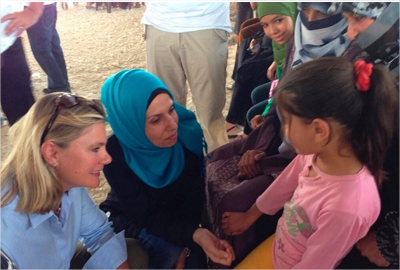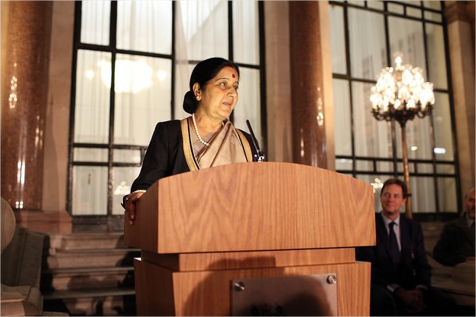1.1: Introducing Intercultural Communication
- Last updated
- Save as PDF
- Page ID
- 48820
What is Intercultural Communication?
Intercultural communication refers to the process of interacting with people who are different from oneself in fundamental ways related to appearance, language, worldviews, or a number of other categories. For many people this phenomenon is part of their everyday lives, for example, in multilingual, multicultural communities or in culturally diverse families. The majority of human societies deal with multiple cultures and multiple languages. The USA has traditionally been one of the few countries in which it is possible to be successful even if one speaks only one language, English (Nieto, 2010). The USA, however, is shifting demographically in ways that are likely to change dramatically attitudes towards language and culture. By the year 2042, demographers tell us, non-Hispanic whites will be in the minority (Roberts, 2008).
The USA is by no means unique in undergoing this process. The means of communication and transportation available today result in more mixing of cultures than ever before. This coincides with trends in commerce and trade in recent decades which have facilitated growing internationalization in all areas of business and economic activity. This process of globalization is facilitated by social media activities of people around the world. Communicating with others who are physically remote is possible through social networks such as Facebook or through online conversations via Skype or chat programs such as WhatsApp. At the same time, political and economic forces are causing large numbers of people to become asylum-seekers or economic refugees, creating more diverse cities and countries throughout the world. This process can also create conflict, sometimes due to concerns of foreigners taking jobs away or changing the character of a region, and sometimes due to fear arising from willful ignorance and xenophobia – the fear of foreigners.
In fact, globalization is by no means, as often portrayed a benign process, benefiting humanity universally. While many in developed countries enjoy international travel, increasing prosperity, and safe communities, those in other parts of the world continue to experience severe deprivations (food, water, housing), mass unemployment, and violent communities. These conditions, along with unequal access to education and healthcare, are often accompanied by corruption and political powerlessness. This has led to mass migrations and social instability. Within developed countries, there are sharp divisions based on geography, social class, and income. These disparities, along with changes in the global economy, have propelled populist and nationalistic leaders in many parts of the world to power.
The Need for Intercultural Communication Today
Given the demographical and globalizing trends of recent decades, in today’s world one is likely to have more encounters (online or in person) with people from different cultures. Technological advances have played a major role in bringing people together. The Internet has reached the remotest corners of the world, as has satellite and online entertainment. People are able to see and appreciate differences in culture, way of life, and ways of interpreting the world at the click of a button. To add to this is the increasing ease of travel to different parts of the world for both work and pleasure (for the privileged). This has possibly resulted in a significant decrease in communication apprehension and a visible increase in the need and desire to be interculturally sensitive and competent. From that perspective, there is certainly a personal incentive for being interculturally sensitive. The openness and flexibility needed for successful cross-cultural exchanges offer benefits in personal and professional interactions of all kinds. Becoming knowledgeable about other cultures is also invaluable in gaining deeper insight into one's own culture. An experience living abroad or in close contact with those from another culture can lead to dramatically changed perspectives on the values and behavior patterns of one's native country.

There is in addition a practical, utilitarian benefit, as companies are increasingly looking for employees who are flexible, tolerant, and able to work with others different from themselves. In virtually every business today, what happens in other countries can have a serious impact on its operations and viability. Communities and societies benefit as well, as understanding and tolerance reduce animosity and conflict. This is of increasing importance today, as we see a rise in nationalistic movements in many countries, often accompanied by growing calls for political isolation, economic nationalism, and stricter immigration controls. In part, this is a response to the fact that the forces of globalization have resulted in disadvantages for particular local populations in terms of job opportunities and economic well-being. These tendencies have unfortunate byproducts, namely the rise of prejudicial attitudes towards members of minority groups and a closing-off of minds and feelings towards those who act or look different.
It is of particular importance for future leaders to gain insight and empathy into other cultures. National or regional officeholders, heads of political parties, and others in the public eye (entertainers, writers, activists) function as role models. Their views, opinions, and behaviors can have a substantial public influence. Figures like Pope Francis, Malala Yousafzai, or Greta Thunberg have exerted positive influence, respectively, on views of minority rights, educational opportunities for girls, and the need for immediate action on global warming. Unfortunately, we have seen in recent years public figures advocating for ideas and policies which divide and inflame communities, such as white supremacy or rejection of equal rights for LBGTQ individuals. Messages of this kind — of hatred and bigotry— can fall on receptive ears, particularly if an individual or a community has not often encountered individuals different in ethnic background, religious belief, or language:
Many societies are deeply divided: the anger of rural and deindustrialised communities cut adrift by neoliberal globalization is readily harnessed against the more concrete scapegoat of minorities, particularly if people have little experience with diversity. Against this context, opportunities for everyday mundane connections that allow people to engage beyond the stereotypes can become a crucial means to overcoming division and exclusion (Piller, 2017, p. 203).
Studies have shown that the geographical regions with the lowest number of immigrants or members of a minority tend to have the highest level of negative views of those groups. This is a clear indication that these views are not based on experience or evidence but on uninformed opinions based on slanted media or anecdotal information from friends or family. Piller (2017) provides a hopeful example, namely Sudanese immigrants in a virtually all-white Australian community becoming socially accepted by individuals and community leaders who reach out beyond stereotypes and their in-group bubbles.
Intercultural understanding is essential as well in gaining an informed and balanced appreciation of media, whether that be television reports focusing on other countries or blog posts from abroad. Today there is a vast amount of information freely available, through media channels and the Internet. Understanding the perspective from which others view the world can be very helpful in becoming informed consumers of news stories and social media. Given the importance of this topic, it will form a thread through many of the discussions in this textbook.
Culture: Central to our lives
Embedded in the term intercultural communication is the word culture. Culture is a slippery concept. In English, it has a number of different uses. Already in the 1950’s, one article cited over 150 definitions of culture (Kluckhohn & Kroeber, 1952), while a more recent study analyzed over 300 definitions (Baldwin et al., 2006). One of those concepts is culture with a capital C, or high culture, namely literature and the arts. When we say in English that someone is cultured, this is the kind of culture we mean, someone with a good education, who perhaps goes on a regular basis to the theater or concerts, and reads books. We won't be talking much here about that kind of culture. Rather what's important for intercultural communication is the concept of culture related to the everyday pattern of life. Neuliep defines culture as "an accumulated pattern of values, beliefs, and behaviors, shared by an identifiable group of people with a common history and verbal and nonverbal symbol systems" (2012, p. 19). We will use this as our initial working definition, refining it subsequently to embrace other concepts beyond that of national cultures, implied in this view. In this traditional description of culture, several ideas emerge as being of importance:
- An accumulated pattern of values, beliefs, and behaviors…
Individual cultural identities develop over time, with handed-down concepts and actions being reinforced through repetition in a gradual socialization process. Culture references a number of aspects of normal human existence, from weighty issues such as our worldview and ethical–moral standards to more mundane matters such as how we greet each other or the kinds of food we like to eat.
- …shared by an identifiable group of people…
These cultural norms represent fundamental, default values for individuals identified with that cultural group. That group may be small or large, fixed in a single location or dispersed among different diaspora communities (geographically separated). However, no matter where they may be, they share particular characteristics that make them a distinct group.
- …with a common history…
How important historical memory is to members of a culture may vary. In some cases, as with Native Americans, or for other groups having been displaced or suffered acute social injustice, their history is likely to be well known and to play a significant role in determining cultural values as well as in shaping interactions with other groups. According to Rogers and Steinfatt (1999), "collective cultural consciousness," the embedded memories of historical events important to a particular cultural group, can act as a kind of "message filter", affecting significantly communication dynamics (p. 3).
- …and (common) verbal and nonverbal symbol systems.
Language plays an oversized role in social cohesion and is the most important vehicle for transmission of cultural values. Nonverbal communication patterns are also a prominent constituent part of a group’s identity and an easily identifiable marker for group membership. Both systems are based on symbols. Some see the use of symbols as the essence of a culture. For anthropologist Clifford Geertz, culture is a complex set of symbols used to create order and sense in our lives. According to Geertz, cultures "denote an historically transmitted pattern of meaning embodied in symbols" (Geertz, 1973, p. 89). As we saw from the example at the beginning of this chapter, while symbols may sometimes seem arbitrary (i.e., no inherent connection to their meaning), they nevertheless can be powerful, embodying deeply-held values and beliefs.

Culture is not something we are born with, but rather it is learned, starting with our families, then moving on to our school experiences and friends. We often are not aware of the cultural values we embrace, even though many of those values and behaviors determine important aspects of our lives. They may only come to the surface when we encounter people who come from different cultures. In that sense, culture is often described as hidden (Hall, 1966). Culture is not fixed and immutable; culture does not exist in a vacuum, but is influenced by historical, social, political, and economic conditions. Cultural values are constructed from social dynamics in the countries or groups represented. Those values are not necessarily universally embraced.
In everyday life, cultures are often associated with nation-states, as assumed in Neuliep's definition. This can be traced back to the work of early 19th-century German scholar Wilhelm von Humboldt, who was one of the first to equate nations with cultures (Rogers & Steinfatt, 1999). We often hear about French culture or Chinese culture. But within political boundaries, cultures are rarely monolithic. There tend to be many regional differences, as well as differences based on ethnicity, age, profession, social class, and other categories. National cultures change, whether it's a consequence of catastrophic events such as wars or natural disasters, or simply
through contact with a foreign culture. One could point to the spread of U.S. culture, for example, through the popularity of American movies and music, as well as through military interventions. In recent years we're seen South Korean popular culture develop a large following outside of Korea. K-pop, as it's called, has many fans worldwide, some of whom adapt aspects of the K-pop sub-culture such as dress, hair style, or mannerisms (Kim, 2013). The fact is that as individuals we don't necessarily fit the mold of the national culture in which we were raised. Some scholars speak of culture as something often contested (see Jackson, 2010; Pillar, 2017). Hippies in the 1960's, for example, saw themselves in opposition to the cultural mainstream of many Western countries, in political views, in dress, and in attitudes towards work and leisure. In the end, culture is personal and fluid.

With these perspectives on culture, we can return to our initial working definition and add some qualifiers. This traditional view of culture implies a static state, not the flexibility described above. It also includes a common history, but a dynamic vision of culture embraces the idea that cultures can be built on the fly, through individuals coming together due to commonalities of one kind or another, possibly even for a short duration of time. Finally sharing values, behaviors and languages may be true only in a restricted sense. It is useful to have knowledge of the traditional conception of culture, but at the same time understand new and different perspectives on what "culture" is. That is further explored in the next section.
Culture from the perspective of complexity theory
We live in a world that has become increasingly complex, with a host of problems both global and intractable:
Economic instability, the widening gap between rich and poor, climate change and the environmental crisis, the unstoppable transnational flow of refugees despite increasingly harsh regimes of border control, the threat of terrorist movements, rising geopolitical tensions as the hegemony of the West declines, urban gridlock and conflict in our hyper-diverse cities, the unsustainable costs of health care in times of population ageing, and the unsettling impact of rapid technological change – these are only a few of the large conundrums facing our globalized, interconnected world today (Ang, 2011, p. 779).
One could easily add to the list a host of issues surrounding the Internet, from cyber security to the loss of privacy and addiction to social media. These problems are long-term and have a variety of causes. They have repercussions in human lives, both local and global. In recent years, the forces of globalization, mechanization, and mass migration have led to social divisions and political upheaval. Economic uncertainty and resentment towards immigrants have led to the growth of economic nationalism, populism, and isolationism across the globe. Common to these developments are ubiquity and complexity – the problems are interwoven in local and global contexts and evince multiple causes and unpredictable outcomes:
In short, everywhere in the world complexity is staring us in the face; its overwhelming impact – socially, economically, ecologically – is increasingly undeniable and inescapable. That the world is terribly complex is now a vital part of global cultural experience, a structure of feeling which has grown more pervasive in the twenty-first century (Ang, 2011, p. 779).
One way of dealing with this increasingly complex world is to pretend the problems do not exist, to engage in willful ignorance, by, for example, disbelieving scientific evidence. Another option is to ignore what happens beyond one's neighborhood. Yet in the 21st-century it is virtually impossible in any part of the world to withdraw completely from interconnections and interdependencies which may be global in scale, but often local in effect. One path is to put forward short-term or partial measures. The danger in that approach is that it tends to lead to simplistic solutions, that may be popular, but in reality misrepresent both the issue and its complexity. Complex problems are not solved by single, simple cause-and-effect explanations. There are typically multiple, changing variables at play, so that any problem-solving is likely to be both complicated and provisional. As conditions change, problem-solving approaches must adapt.
The first step is to recognize and accept the complexity of a problem and seek to understand its origins and developmental path. An approach that has gained currency in both natural and social sciences is complexity theory (CT), an ecological approach which stresses nonlinearity, unpredictability, and self-organization in how systems work. An expanded version of chaos theory, complexity theory looks to uncover a system's beginning (its “initial conditions”) and to trace development as variables and subsystems are added to combine and shape outcomes in ways that are unpredictable. Studies have shown the extent to which language and language learning can be understood as complex systems, given the variability of language use and the multiple factors which affect learning a second language (Larsen-Freeman, 1997). That approach has recently been used as well to analyze the dynamics of informal language learning (Godwin-Jones, 2018). In chapters three and four we will look at that topic in more detail. Another area within intercultural communication that invites a CT analysis is personal identity, a topic we will address in the next chapter.
Culture and intercultural communication competence from a CT perspective helps us understand that reducing culture to national origin is a simplistic misrepresentation of the dynamics of identity formation today, in which multiple influences – in person, online, and in the media – combine in unique ways that are varied and unforeseeable. Holliday (1999) uses the term “networked individual” to point to the myriad influences on individuals in our time. Culture from this perspective is fluid and dynamic, impacted by diverse, intersecting factors and not reducible to a single point of origin. The complexity of culture can also lead us to realign the typical approach in intercultural communication studies of focusing on similarities or differences. There are too many variables in play for contact between cultures to be understood in such binary terms. It is preferable to imagine instead a sliding scale, with both context and individual affecting interactions.
Communication: A Human Necessity
Communication occurs in many different contexts, and conversations will have different characteristics depending on who is speaking, where the exchange takes place, and what the purpose of the encounter is. Human conversation is highly contextual and infinitely variable. The linguist Noam Chomsky has made us aware of the fact that virtually every sentence we speak is something brand-new, combining a basic set of elements into endless combinations, a phenomenon known as digital infinity (Chomsky, 2005).
According to the popular conception of human speech, language is used primarily for the transmission of information. This familiar transmission model breaks communication down into a transmitter and a receiver, whose roles may be reversed in the course of a dialogue, but whose purpose in talking is to send a message of some kind. This is a concept derived from early work in electronic communication, such as that done by Bell Labs in the US in the 1040's and 1950s (see Shannon, 1948). In 1960, Berlo expanded the communication model to include factors such as the purpose and objectives of the message being transmitted, as well as nonverbal communication. His "SMCR" model breaks down communication into the Sender, Message, Channel, and Receiver, each of which is affected by a variety of factors. One of the important modifications in the model is emphasis on the channel's influence on message transmission. This was later popularized in the phrase, "the medium is the message," by Marshall McLuhan (1964), meaning that a message is tightly tied to the means of transmission. This is of particular relevance today, as digital media have provided multiple channels of communication — texting, email, Facebook messaging, tweets, Instagram posts, etc. – all of which have a shaping influence on how a message is received.

In the traditional model of communication, the major emphasis is on how a message is transmitted. Yet linguists, from observing and studying actual conversations, have learned that rarely does a conversation have only a semantic purpose, i.e., used to convey meaning. Instead, talking is often a social action, used to maintain relationships and convey feelings and emotions. Sometimes conversations are shaped by social status and function as a way to affirm or contest a hierarchical status quo (see Sorrells, 2013). Humans are social animals and the need to communicate is fundamental to our nature. Communication is what builds and maintains communities. Historically, the worst kind of human punishment has been exclusion from a community and enforced verbal isolation (see sidebar). Like culture, we take human communication for granted, and feel its importance only when it is lost.
The nature of human speech affects intercultural communication. If talking is essentially a socialization process, holding conversations has the potential to build relationships. But that also means that the language we need for engaging in normal conversation is not simply vocabulary useful for expressing meaning. We need, importantly, to know about the social dimensions of language, i.e. the appropriate way to greet others, how to express gratitude, or what topics are appropriate to introduce in a conversation. Communication is fundamentally cultural. To be effective, conversation partners need to be sensitive to a range of factors beyond verbal communication. That includes nonverbal actions, such as how close to stand to the other person or whether to maintain eye contact (see Hall, 1966).
No communication = no community
Throughout history, when societies wanted to severely punish someone for a social transgression, the harshest punishment was excommunication — banishment from the community. In Catholicism this means to cast out someone from the church. In ancient Rome the process was called ostracism, a ritual in which citizens used clay shards (ostraca) to vote for someone to be sent away from the community for 10 years. In modern Amish communities the practice is called shunning. The shunned person is allowed to physically remain in the community but is prohibited from any social interaction with others
Remland et al,, 2014. p. 9
Those kinds of considerations we need not think about if the conversation is with a person or a group with whom we are familiar (Hall, 1959). When we speak of intercultural communication, we are moving away from that comfort zone, engaging in exchanges with people representing different cultures, that is to say different sets of values, beliefs, and behaviors; a different historical memory; quite possibly a different language (or dialect). The individual may not, in fact, represent the mainstream culture. Thereby we construct and convey different meanings in unfamiliar contexts. That type of communication can be very different from encounters with those with whom we share a culture, in which the context is familiar. As a result, intra-cultural conversations tend to be more comfortable and routine. Even so, depending on the situation or context, we may experience conflict or communication apprehension. Speaking in front of a group, for example, can produce anxiety for many people. Conversing with strangers can bring on even more apprehension. This comes in large part from uncertainty. The less we know about the other person's background and intentions, the more uncertain and apprehensive we may be. We can combat these feelings through approaching encounters in a spirit of openness and discovery. That lessens the likelihood of misunderstanding and conflict.


